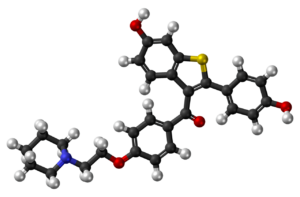Six months of patient trials with the ostensible COVID-19 therapeutic remdesivir have cast serious doubt on its ability to even reduce the severity of COVID-19, let alone reliably reduce patient mortality. This has left medical professionals once again without a proven COVID-19 therapeutic as the pandemic shows signs of reaching unprecedented spikes in Europe and North America. As the world confronts the possibility of a dark winter, a supercomputer-powered pharmaceutical research coalition based in Italy is producing a glimmer of light: a repurposed drug called raloxifene, identified by supercomputing research, that will now be entering clinical trials to test its efficacy as a therapeutic for COVID-19.
 The coalition in question is Exscalate4CoV, a public-private partnership spanning 50 partners across seven European countries (Belgium, Germany, Italy, Poland, Spain, Sweden and Switzerland). Led by Italian pharmaceutical firm Dompé, Exscalate4CoV leverages Dompé’s “exascale smart platform against pathogens” (Exscalate) and its accompanying chemical library of half a billion molecules in service of one goal: drug development for COVID-19.
The coalition in question is Exscalate4CoV, a public-private partnership spanning 50 partners across seven European countries (Belgium, Germany, Italy, Poland, Spain, Sweden and Switzerland). Led by Italian pharmaceutical firm Dompé, Exscalate4CoV leverages Dompé’s “exascale smart platform against pathogens” (Exscalate) and its accompanying chemical library of half a billion molecules in service of one goal: drug development for COVID-19.
Included in these 50 partners are an armada of supercomputer centers across Europe: CINECA in Italy; Barcelona Supercomputing Center (BSC) in Spain; Jülich Supercomputing Centre in Germany; and the KTH supercomputing center in Sweden. In total, the coalition claims it has access to “around 120 petaflops” of supercomputing power.
Finding raloxifene
Exscalate4CoV formed in mid-February, mere weeks before Italy was set to become the first true epicenter of the pandemic outside of China – and by early March, it had been awarded €3 million by the European Commission for COVID-19 research. As the pandemic raged across Europe, Exscalate4CoV began crunching Exscalate’s enormous molecular library.

Within a few months after that award, the consortium had tested over 400,000 molecules for their ability to dock with SARS-CoV-2’s viral proteins. This screening work was performed on four leading European supercomputers: oil and gas firm ENI’s private HPC5 system (51.7 peak petaflops); CINECA’s Marconi-100 system (29.4 peak petaflops); BSC’s MareNostrum 4 system (13.7 peak petaflops); and Jülich’s Juwels system (12 peak petaflops, soon to dramatically increase).

After whittling those 400,000 molecules down to 7,000 that were tested in vitro, Exscalate4CoV identified one particularly promising preexisting pharmaceutical: raloxifene, a generic drug designed to help treat and prevent osteoporosis in postmenopausal women. Exscalate4CoV theorized that raloxifene might be able to halt the spread of the virus in mildly symptomatic COVID-19 patients by using estrogen as a defense.
“The selected drug is well-tolerated, has a well-known toxicological profile in the clinic and has shown great efficacy in in vitro experimentation,” said David Vannozzi, director of CINECA, at the time. “Now, we move on to in vivo experimentation, on animals and then on humans.”
The final test

Now, over four months later, the time for human trials has come. Exscalate4CoV has announced that, as a result of its research, AIFA (the Italian pharmaceutical regulatory agency) has greenlit a clinical trial of raloxifene. The study, based at the National Institute for Infectious Diseases in Rome and the Humanitas Research Hospital in Milan, will consist of up to 450 participants split into three treatment groups. The participants will be administered a seven-day course of either raloxifene or a placebo, after which they will be monitored for 12 weeks. Researchers will be assessing whether raloxifene safely and efficiently blocks the replication of the SARS-CoV-2 virus in human cells.
“It inhibits virus replication, thus preventing the worsening of patients with mild symptoms, and also decreases infectivity, limiting the viral load,” Marco Allegretti, head of research at Dompé, told Reuters. To that end, Dompé, the Fraunhofer Institute and the University Leuven filed a patent for the use of raloxifene in early May “in order to promote universal access to treatment,” which the consortium stressed is core to its founding principles.
Despite the promising research, Exscalate4CoV cautioned that the drug is not licensed for use in this manner outside of clinical studies as, to date, there is no conclusive evidence that raloxifene carries more benefits than risks when used with COVID-19 patients, nor is there evidence on effective dosage amounts. (In short: don’t try this at home.)
Exscalate4CoV’s ongoing research
The raloxifene research is far from the only work emerging from Exscalate4CoV. In addition to the data from its massive molecular docking initiative and over 20,000 in vitro experiments, the consortium already has ten finalized peer-reviewed articles, with ten more approaching finalization. This research, of course, is open access, with the papers available here and the data available here. Finally, the consortium is currently evaluating two additional drugs for use as COVID-19 therapeutics.
These results (and the ensuing ongoing studies) are the product of now-complete phase one of Exscalate4CoV, which aimed to identify promising molecules for those already infected with COVID-19. The second phase will aim to identify molecules capable of inhibiting future infections.
To learn more about Exscalate4CoV’s coronavirus research, listen to or read HPCwire’s interview with CINECA’s Carlo Cavazzoni, conducted at the height of Italy’s battle with COVID-19.





























































